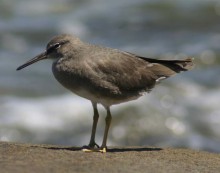Tringa incana
Subspecies
None. Sometimes considered co-specific with the Grey-tailed Tattler.
Other Names
American Wandering Tattler.
Identification
Medium-sized dark grey bird of rocky shores.
Plumage
Non-breeding: Upperparts are slate-grey the cheeks appear paler. The underparts are white. The supercilium is white not really extending past the eye, but seems to meet on the forehead over the bill. The bill is black with yellow on the rear third of the lower mandible. The legs are yellow.
Breeding: The upperparts are slate-grey with individual feathers of the back having a darker margin giving a scalloped appearance. The supercilium looks whiter. The sides of the head are white heavily streaked with grey. The underparts are white with the breast and flanks marked with V-shaped grey bars. The bill is black with yellow on the rear third of the lower mandible. The legs are bright yellow.
Juvenile: Similar to the non-breeding plumage but the upperparts appear spotted.
Distribution
The Wandering Tattler is found singly or in very small numbers on coral cays or rocky shores in Queensland and New South Wales.
Migratory habits
This bird usually migrates down the west coast of North America and as far south as Peru. Amazingly some of the birds migrate across the Pacific and are found throughout the islands of the central and south-western Pacific. They have been recorded on Hawaii, French Polynesia, eastern Micronesia, Solomon Islands, Fiji etc. The birds arrive in late September though this seems to go through until November. The birds leave April.
Breeding
This species breed in Alaska and north western Canada, as well as eastern Siberia.
Status
An uncommon visitor to our shores, though a number of birds might be overlooked because of its similarity to the Grey-tailed Tattler. Its liking of rocky shores could well mean that birds missed on the cays and islands of the Great Barrier Reef.
Confusing Species
Grey-tailed Tattler: This species has paler upperparts. The supercilium extends well behind the eye. Both birds like rocks to roost on.

